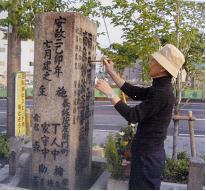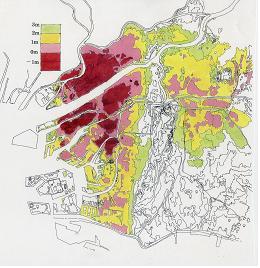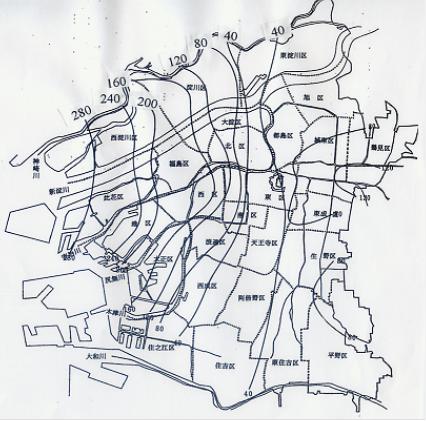When both the Hoei and Ansei earthquakes happened, people were frightened of the violent shaking and fled into boats. People on the boats felt safe and relieved, but shortly afterwards, a tsunami hit Osaka Bay.
Large cargo ships which were carried up the canals by the tsunami crashed into the small boats. Several documents stated that the fatalities ran into the thousands. The inscription on the memorial warns people not to board boats when earthquakes occur.
Why did people flee into boats when the earthquakes occurred? In the Edo era big fires often broke out in Osaka City. During fires, people used to flee into boats with their possessions. When earthquakes occurred, people were wary of fires. They did not consider tsunamis. The streets of Osaka were narrow, so people thought the wider canals were the safest place. The people in Osaka who suffered from the Ansei Nankai earthquake tsunami regretted that they did not learn the lesson from the Hoei earthquake tsunami. A year after the Ansei Nankai earthquake tsunami, they built a stone monument not only as a memorial for the victims of the earthquake and tsunami, but also as a warning for future generations.
The memorial inscription includes a lot of information about earthquakes and tsunamis. People are warned not to forget the lessons learned from the disaster. The memorial inscription begins with the Igaueno earthquake, which occurred five months before the Ansei Nankai earthquake. It is possible that other earthquakes tend to occur inland before a powerful earthquake occurs at the bottom of the Nankai trough.
The inscription describes ground liquefaction: "Tsunamis rush in not only from offshore but also from the bottom of the shallows near the sea or rivers. The muddy water springs up in reclaimed land." This phenomenon was caused by the shaking of the earthquake, and was not related to a tsunami.
Since the beginning of the Edo era the area of reclaimed land has grown to 11,600 hectares. Especially since the period of rapid economic growth, land reclamation has accelerated. Even though economic growth has slowed down, reclamation has continued. Recently, at Kansai airport, even at a depth of 20 meters, reclamation has been underway.
When the Hanshin earthquake occurred, liquefaction happened on Rokko Island and Port Island (reclaimed land) where they had taken modern measures against liquefaction.
Hereafter we should develop better safeguards against liquefaction. Over 150 years have passed since the construction of the memorial to the Ansei Nankai earthquake tsunami. Now the landscape along the Kizu River has been transformed and the residents changed. However the memorial has been preserved by the people of Saiwaicho (Photo 2). As the last sentence of the inscription states, "It is my desire that over the years people of conscience would add ink [to this inscription] in order to keep it legible."
 | Fhoto 2. Saiwaicho resident Kenzo Masui, whose family has been adding ink to the memorial for five generations. |
| 2.1. The Lessons of the Ansei Nankai Earthquake |
We have extracted important lessons from the inscription. *2
(1) "Do not board boats when a powerful earthquake occurs, because a tsunami might hit after the earthquake."
During the Ansei Nankai earthqake tsunami most of the fatalities were due to people freeing into boats, afraid of the terrible shaking. The tsunami which ran up the Kizu River and the Aji River swiftly carried large cargo ships up the canals in Osaka. They crushed small boats and many people drowned.
People who suffered at the time of the Ansei Nankai earthquake tsunami thought that boats in canals were the safest place when a powerful earthquake occurred. They had completely forgotten the lessons of the Hoei earthqake tsunami which had occurred 147 years earlier.
(2) "Be careful of fires."
The Bugyosho ordered the town's senior officials to conduct fire patrols to protect the streets, including the back streets. When earthquakes occur, fires tend to break out; the men on fire patrol also needed to protect against looting. At the time, houses were made of wood and paper. If fires broke out, the damage was devastating. When the Ansei Nankai earthquake occurred, protection against fire was thorough; only a few fires occurred and they were put out quickly.
(3) "Money and bonds should be kept in the warehouse"
Warehouses were protection not only against fire but also theft.
(4) "Ships on the river should be moored in calmer areas".
In winter, ships resting for repair should be pulled up as high as possible. During this tsunami, large ships moored or resting on the mouth of either river were carried up the canals in Osaka City, causing a lot of damage. Therefore, we should take measures to prevent ships from being carried by tsunamis when powerful earthquakes occur.
(5) "A lot of muddy water springs up from the reclaimed land along the shore."
The inscription says that a lot of muddy water sprang up from the reclaimed land along the shore. This phenomenon, known as liquefaction, occurred at the time of the Ansei Nankai earthquake. The damage, however, was not so extensive because the area of reclaimed land was far from Osaka City and few people lived there. However, the inscription notes and warns against this phenomenon.
| 2.2. Applying the lessons of the Edo era to modern protection against tsunamis. |
In modern times the Osaka Bay area has been developing, and the lowland area has become densely populated. What is worse, land subsidence, caused by heavy reliance on ground water, continued for several decades. It is most serious in western Osaka City where the maximum recorded subsidence is about 3.0 meters (Fig. 2). Today in Osaka City, the area of ground height below sea level is 21 square kilometers(Fig. 3). If a tsunami ever hits Osaka again, we must run for higher ground.
 | Fig. 3. Height of the land in Osaka city (1990). Based on a map of ground height in Osaka, compiled by the Geographical Survey Institute. I colored four levels of ground height under 3.0 m. |
*1 The memorial was originally erected at the ferry station. There was no bridge at that time. Taisho Bridge was constructed in 1915.
*2 [Nagao, T. (2012a)], [Nagao, T. (2012b)]
